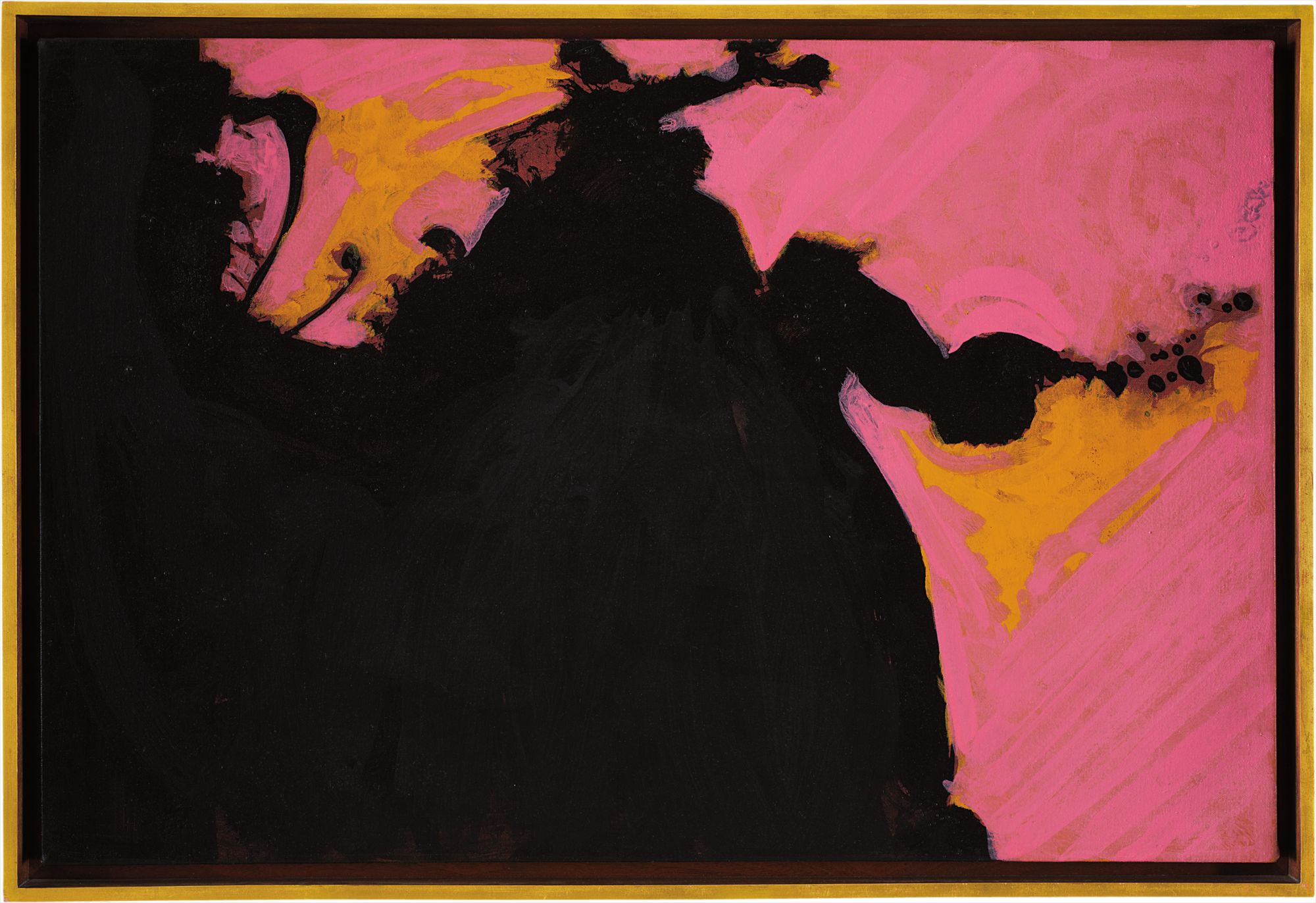

157
Robert Motherwell
Untitled (Black Ochre Pink)
Full-Cataloguing
ROBERT MOTHERWELL, 1971
A major figure of the Abstract Expressionist generation, Robert Motherwell entered into what is considered to be one of the most important periods of painting in art history
during a time that would ultimately change the face of American painting. Influenced by Surrealism, this young group of artists, including Jackson Pollock and Mark Rothko, renounced the commonplace realist style prevalent at the time as they believed it only scratched the surface of American culture. Instead, their interests laid in examining a broadened and less palpable truth that existed beyond easily recognizable imagery. Thus, the Abstract Expressionists made it their goal to create work that depicted an accumulation of emotional truth, authenticity, and the freedom associated with postwar life in the United States.
Motherwell was the youngest and one of the most prolific figures of the group, playing a significant role in the intellectual development of the art world at that time. Originally hoping to be a philosopher, the artist turned to painting after moving to New York and spending time with the Surrealists, a group who shared his academic and creative ambitions. To Motherwell, abstraction was the process of peeling away the inessential and presenting the necessary. Armed with a psychoanalytic background and knowledge of free association, he began to shape the theory of automatism which allowed chance to play a major role in artistic creation. These ideologies ultimately lead to the inception of action painting.
During Motherwell’s mature years he began to create works that comprised both the poignant brushwork of action painting with the broadened scales and intense chromatism of color field painting. Admired for his spirited ingenuity, the dramatic nature of his painterly process is marked by the bold consummation of movement and decorative abstraction that successfully married the avant-garde with European traditions and rendered raw emotions through visual interpretation.
The present lot, Untitled (Black Ochre Pink), 1977-79, a vibrantly saturated amalgamation of automatist spontaneity and areas of broad fat color, is a prime example from
a series of works on canvas that began in the 1960s and extended through the latter part of Motherwell’s career. Executed in his signature poetic and powerful approach, in
which imagery is generalized to convey a mood rather than distinct representation, Untitled (Black Ochre Pink), is a spry assertion of audacious forms and gestural lines. The
oversaturated black silhouette dominating the piece seems daunting when placed against the tranquility of the pink background creating an aesthetic antithesis in both color and composition. Contour delineations surrounded by ochre creep across canvas in a loose manner balancing severity of form with casual visual subversions in a melodious juxtaposition between harmony and ire. This jovial contention remains one of the most compelling aspects in Motherwell’s work. As the artist put it, “Drama moves us: conflict is an inherent pattern in reality. Harmony moves us too: faced as we are with ever imminent disorder. It is a powerful idea.” (‘Beyond the Aesthetics’, Robert Motherwell, in ‘Design 47′, no 8, April 1946, pp. 38-39.)
In a market saturated with Pop Art, Motherwell’s large abstract paintings retain an idealistic quality. His esoteric nature and emotional purity regarding social and political
matters as well as artistic creation serve as welcome contrast to the customary cynicism of the post-modern era. As Motherwell stated in his 1942 essay The Modern Painter’s World, “We must remember that ideas modify feelings. The anti-intellectualism of English and American artists has led them to the error of not perceiving the connection between the feeling of modern forms and modern ideas. By feeling is meant the response of the ‘body-and-mind’ as a whole to the events of reality.” Despite the overwhelming emphasis on popular culture themes adapted by his peers, Motherwell remained committed to creating emotionally-charged and intellectually stimulating work for the entire duration of his life.
Today, his legacy is upheld as one of the most prominent and public voices in abstraction leaving behind an impressive collection of writings, painting, prints and collages that remain an extensive contribution to modern art and a testament to the emotional integrity upheld by abstract expression. On July 16, 1991, at the age of 76, Motherwell died. Upon his death, Clement Greenberg, openly expressing his respect for the artist commented that, “although he is underrated today, in my opinion Robert
Motherwell was the very best of the Abstract Expressionist painters”.
Robert Motherwell
American | B. 1915 D. 1991One of the youngest proponents of the Abstract Expressionist movement, Robert Motherwell rose to critical acclaim with his first solo exhibition at Peggy Guggenheim's Art of This Century gallery in 1944. Not only was Motherwell one of the major practicing Abstract Expressionist artists, he was, in fact, the main intellectual driving force within the movement—corralling fellow New York painters such as Jackson Pollock, Willem de Kooning, Hans Hoffman and William Baziotes into his circle. Motherwell later coined the term the "New York School", a designation synonymous to Abstract Expressionism that loosely refers to a wide variety of non-objective work produced in New York between 1940 and 1960.
During an over five-decade-long career, Motherwell created a large and powerful body of varied work that includes paintings, drawings, prints and collages. Motherwell's work is most generally characterized by simple shapes, broad color contrasts and a dynamic interplay between restrained and gestural brushstrokes. Above all, it demonstrates his approach to art-making as a response to the complexity of lived, and importantly felt, experience.